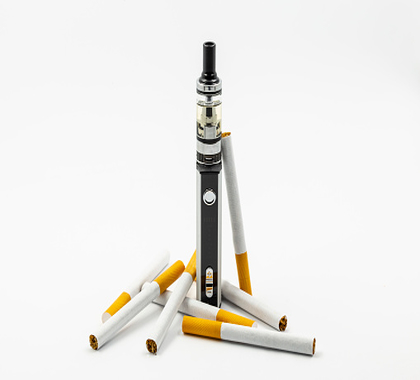Aldermen in Chicago are considering a local ordinance that would prohibit the sales of flavored liquid nicotine products, going further than most other proposals in other states that do allow mint or menthol flavors and to which industry has already responded.
Ostensibly, the ordinance intends to reduce vaping by the city’s youth. And although addressing youth use of nicotine products is laudable, there is little evidence that flavor bans reduce youth e-cigarette use. Undoubtedly, such a ban would create a booming black market for flavored e-cigarettes that are consumed legally (as of now) by millions of American adults.
The Heartland Institute examined the effects of flavor bans, finding these measures to have no impact on youth e-cigarette use. For example, Santa Clara County, California, banned flavored tobacco products to age-restricted stores in 2014. Despite this, youth e-cigarette use increased. In the 2015-16 California Youth Tobacco Survey (CYTS), 7.5 percent of Santa Clara high school students reported current use of e-cigarettes. In the 2017-18 CYTS, this increased to 10.7 percent.
Further, flavors have helped millions of adults transition from combustible cigarettes to tobacco harm reduction products. Indeed, a 2018 survey of nearly 70,000 American adults noted that 83.2 percent and 72.3 percent of survey respondents reported vaping fruit and dessert flavors, respectively. Further, only 20 percent of respondents reported using tobacco flavors at point of e-cigarette initiation.
The substantial decline in youth cigarette use is likely attributable to electronic cigarettes. Although youth use of e-cigarettes is worrisome, the 2018 data indicates that fewer students are vaping than when cigarette use was at an all-time high. In 2018, only 20.8 percent of students reported using e-cigarettes, which is a huge decrease from 1997, when 36 percent of high school students reported combustible cigarette use. Use of any and all tobacco products were still significantly lower in 2018 than 1997. Indeed, tobacco product use has decreased from 42.7 percent of high school students reporting tobacco use in 1997 to only 27.1 percent of high school students reporting tobacco product use in 2018. It is disingenuous that alders would move to ban flavored nicotine products now while turning a blind eye to youth tobacco use when it was much more common.
Youth use of tobacco products other than e-cigarettes is at an all-time low. Although addressing youth use of vaping products is worthwhile, flavor bans have had no reduction on youth e-cigarette use. Worse, an all-out ban on flavored e-cigarettes will almost surely lead hundreds of thousands of former smokers back to combustible cigarettes.
Undoubtedly, a black market will fill the void in the market because the law of supply and demand is always victorious. Lawmakers should refrain from enacting brainless bans and focus on adequately funding programs that address youth tobacco use, including education and prevention efforts.
The following articles provide more information on e-cigarettes and tobacco harm reduction.
Tobacco Harm Reduction 101: A Guidebook for Policymakers
https://heartland.org/publications-resources/publications/latest-heartland-policy-booklet-addresses-vaping-myths
This booklet from The Heartland Institute aims to inform key stakeholders on the much-needed information on the benefits of electronic cigarettes and vaping devices. Tobacco Harm Reduction 101details the history of e-cigarettes, including regulatory actions on these products. The booklet also explains the role of nicotine, addresses tax policy and debunks many of the myths associated with e-cigarettes, including assertions about “popcorn lung,” formaldehyde, and the so-called youth vaping epidemic.
Podcast Series: Voices of Vapers
https://heartland.org/multimedia/podcasts?fromDate=&toDate=&q=voices+of+vapers
In this weekly podcast series, State Government Relations Manager Lindsey Stroud talks with researchers, advocates, and policymakers about tobacco harm reduction and electronic cigarettes. The series provides important information about the thousands of entrepreneurs who have started small businesses thanks to THRs and the millions of adults that have used electronic cigarettes and vaping devices to quit smoking tobacco cigarettes.
Vaping, E-Cigarettes, and Public Policy Toward Alternatives to Smoking
https://heartland.org/publications-resources/publications/vaping-e-cigarettes-and-public-policy-toward-alternatives-to-smoking
For decades, lawmakers and regulators have used taxes, bans, and burdensome regulations as part of their attempt to reduce the negative health effects of smoking. Recently, some have sought to extend those policies to electronic cigarettes. This booklet from The Heartland Institute urges policymakers to re-think that tax-and-regulate strategy. Policymakers should be mindful of the extensive research that supports tobacco harm reduction and understand bans, excessive regulations, and high taxes on e-cigarettes often encourage smokers to continue using more-harmful traditional cigarette products.
Research & Commentary: Centers for Disease Control and Prevention Link Major of Vaping-Related Hospitalizations to THC Product
https://heartland.org/publications-resources/publications/research–commentary-centers-for-disease-control-and-prevention-link-majority-of-vaping-related-hospitalizations-to-thc-products
In this Research & Commentary, Heartland State Government Relations Manager Lindsey Stroud examines the Centers for Disease Control and Prevention’s Morbidity and Mortality Weekly Report which found nearly 77 percent of vaping-related hospitalizations are due to the use of tetrahydrocannabinol products. These findings are similar to what have been reported in other states, including Connecticut, Oregon, Texas, and Utah.
Research & Commentary: Flavor Bans Do Not Reduce Youth E-Cigarette Use
https://heartland.org/publications-resources/publications/research–commentary-flavor-bans-do-not-reduce-youth-e-cigarette-use
In this Research & Commentary, State Government Relations Manager Lindsey Stroud examines the California Youth Tobacco Survey results from 2017-18, finding youth vaping has increased in several California localities that have restricted access to flavored tobacco product. Stroud finds youth vaping has increased in both Santa Clara and Contra Costa counties. Stroud also notes that banning flavored e-cigarettes is likely to reduce the number of adult smokers switching from combustible cigarettes to tobacco harm reduction devices, and could lead former smokers back to cigarettes.
Research & Commentary: Qualitative Study on E-cigarettes Shows More Evidence of Tobacco Harm Reduction
https://heartland.org/publications-resources/publications/qualitative-study-on-e-cigarettes-shows-more-evidence-of-tobacco-harm-reduction?source=policybot
In this Research & Commentary, Heartland Institute State Government Relations Manager Lindsey Stroud examines a study, published in The International Journal of Environmental Research and Public Health in June 2016, that provides additional evidence showing e-cigarettes and vaporized nicotine products (VNPs) are an effective tobacco harm-reduction tool.
____
Nothing in this Research & Commentary is intended to influence the passage of legislation, and it does not necessarily represent the views of The Heartland Institute. For further information on this and other topics, visit the Budget & Tax News website, The Heartland Institute’s website, our Consumer Freedom Lounge, and PolicyBot, Heartland’s free online research database.
The Heartland Institute can send an expert to your state to testify or brief your caucus; host an event in your state; or send you further information on a topic. Please don’t hesitate to contact us if we can be of assistance! If you have any questions or comments, contact Heartland’s government relations department, at [email protected] or 312/377-4000.




